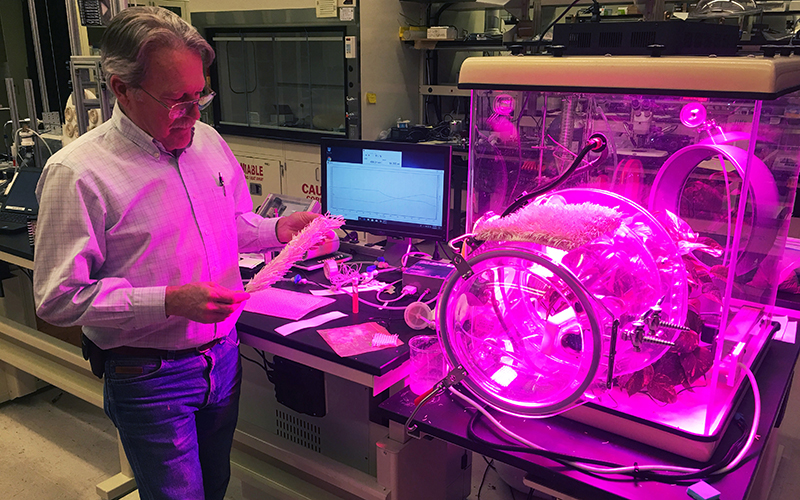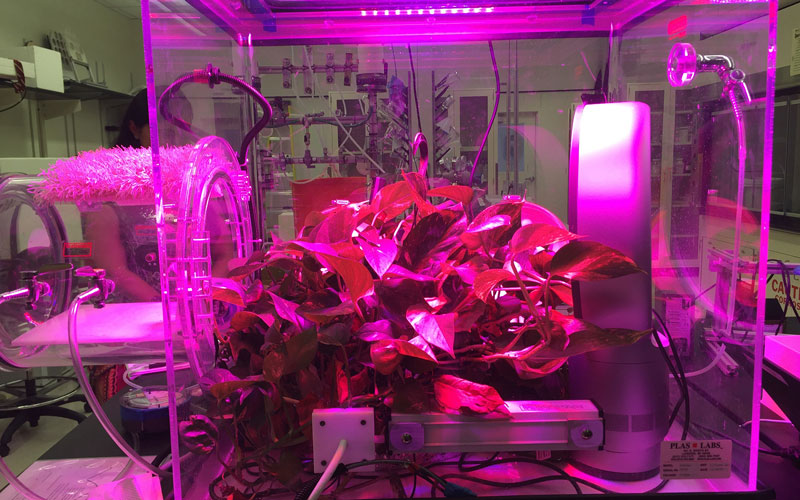
Allen Wright, executive director of the Center for Negative Carbon Emissions at Arizona State University, monitors carbon dioxide and moisture levels inside a plant chamber to study and demonstrate the capture and release of the greenhouse gas. (Photo by Lillian Donahue/Cronkite News)

Allen Wright has been working with a team at Arizona State University to develop a material that captures carbon dioxide using a mat made of porous plastic infused with an anionic resin that captures the deadly greenhouse gas when dry. (Photo by Lillian Donahue/Cronkite News)
TEMPE – It looks like a carpet and acts like a sponge, but it’s actually a key innovation aimed at curbing rising carbon dioxide levels in the air.
Allen Wright directs the Center for Negative Carbon Emissions at Arizona State University and has spent more than 15 years researching ways to “scrub” the dangerous greenhouse gas from the atmosphere.
“Most of the scientific community believe that removing the carbon dioxide from the atmosphere is going to be a necessary component of the strategies that we will use to deal with this rising CO₂ level in the environment,” Wright said, standing in his lab and illuminated in a fuchsia glow.
“Those early days, nobody knew anything. Most people thought it couldn’t be done, or it would never be done or there was no way to do it.”
Wright accepted the challenge of collecting carbon dioxide from the atmosphere and, in 2003, started Global Research Technology in Tucson. He joined the ASU center in 2014.
He and his team have been working on a material that captures CO₂ from the atmosphere in hopes of one day countering the warming effects of greenhouse gases on a larger scale. But they’re a long way from scaling up to commercial applications, which are likely to be costly.
“As it gives off water vapor, it soaks up CO₂,” Wright said about his technology, which looks a lot like shag carpet but actually is a porous plastic infused with an anionic resin. As the material dries, it attracts carbon dioxide from the air. When it gets wet, the gas is released back into the atmosphere.
But capturing the gas is just part of the solution. Wright said an everyday way to collect the gas for sequestration and store it as a gas, liquid or solid is needed. Some sequestration occurs naturally, including in forests and oceans, but what happens when there’s too much carbon in the atmosphere for nature to handle?
“Unless you can get your hands on it (carbon dioxide), you can’t do anything,” he said.
Carbon dioxide made up 81 percent of all greenhouse-gas emissions from human activities in 2016, according to the Environmental Protection Agency. Greenhouse gases trap heat and raise atmospheric temperatures. According to the World Meteorological Organization, the past four years have been the hottest on record.
– Video by Lillian Donahue/Cronkite News
Last year, national carbon dioxide levels increased 3.4 percent, the second largest annual gain since 1996, according to preliminary data released by Rhodium, a New York research group.
The report noted an increased demand for air travel and diesel fuel as the leading causes.
“The transportation sector retained its title as the largest source of CO₂ emissions in the U.S. for the third year running,” the report said.
Everyday commuters also play a role in heightened greenhouse-gas emissions.
Wright used a 1-pound bag of sand to demonstrate how much carbon dioxide one car puts into the atmosphere with every mile on the road.
“If a car gets 20 miles a gallon, that’s the weight of the carbon dioxide that you put in the air every mile that you drive,” Wright said. “I live 18 pounds from here.”
Annual data by the Arizona Department of Transportation show vehicle registrations in the state, including total commercial and private vehicles, increased from 7.9 million to 8.5 million from 2016 to 2018.
Rhodium said its researchers don’t expect CO₂ levels to increase as much this year mainly because of continued closures of coal-powered energy plants and a slower economic year.
Despite this, Wright said continuously paying attention to CO₂ levels and pushing toward innovative ways to deal with emissions will help secure a safer, and greener future.
He and his team at ASU hope to make CO₂ capture devices more readily available. However, that dream will take more time and money to get the technology ready for large-scale use. Wright estimated the total costs of research and construction of the first large commercial prototype would have a $20 million price tag.
“We pay companies to come and haul our garbage off to the dump. We pay taxes to have infrastructure in cities that take care of sewage and waste and all this stuff,” he said. “We haven’t done anything with CO₂ yet, so that’s what we need to do.”
Sign up for CRONKITE DAILY to catch up on the latest news.
